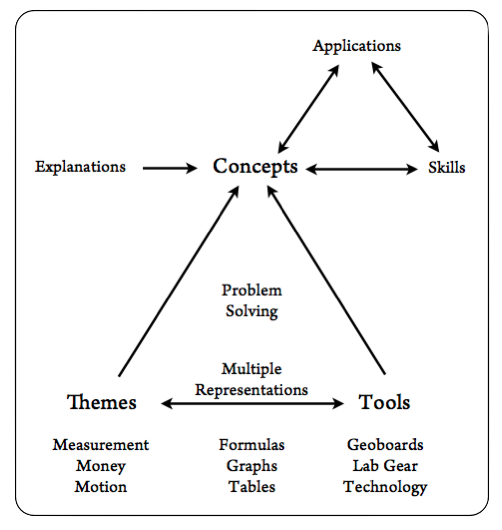
The above map is an attempt at a curriculum development model. Traditional pedagogy stays at the top, as it is based on the belief that skills practice and teacher explanations are sufficient to build student understanding. Understanding acquired this way, plus the skills, allow the student to apply the ideas.
Would that it were that simple.
In my experience, concepts are best developed by spending a lot of time at the bottom of the map. The interaction of themes, representations, and tools provides a foundation on which concepts can develop. (In the map, I mention examples of themes, representations, and tools. Those lists are not meant to be exhaustive.)
The idea is not to rule out explanations and practice, but to give them a chance of being effective.
This is pretty complicated, you say? Where does one start? In thinking about curriculum one often starts with a concept one wants to teach. From there, one can look at the bottom of the map for ways to build up the necessary experiences for students.
But it’s also possible to start with a theme. I developed a whole lot of curricular material, and wrote an article about it based on an exploration of how the theme of area interacts with various tools and representations, and leads to various concepts. Check out this out-of-control figure.
Or one could start with a tool, and ponder what uses it may be put to. We did just that at a recent meeting of Escape from the Textbook! I’ll report on that in a future post. Meanwhile, read my article on a tool-rich pedagogy.
–Henri
[…] themes (contexts), multiple representations, and learning tools. I explained this in more detail in a 2014 post and in various articles over the years. Later in 2014, I sketched a mind map using the TTC […]
LikeLike
[…] PS: I recently returned to the topic of a tool-rich pedagogy in this article. I expanded the diagram in this blog post. […]
LikeLike
[…] Therefore, another dimension of de-tracking has to involve pedagogy: teachers need to be trained in diversifying their toolbox. “Listen carefully and then practice” will not work well, even if the curriculum is improved. In order to be successful, direct instruction must be combined with techniques that center and prioritize student intellectual engagement. Among other approaches, the thinking classroom, and complex instruction can help. See also my article For A Tool-Rich Pedagogy and the figure in this blog post. […]
LikeLike
[…] As it turns out, I have spent much of my career as a teacher and curriculum developer in an effort to ground algebra instruction in the experiential. The textbook I co-authored in the 1990’s (Algebra: Themes, Tools, Concepts) has some weaknesses, but it’s all about laying a concrete foundation for algebraic abstractions. In its title, “Themes” refers to so-called real world problems — a good place to start a lesson. “Tools” refers not only to the increasingly fashionable electronic tools, but also to the manipulative materials beloved by “object visualizers”, including pattern blocks, the geoboard, and the Lab Gear. (These would likely have been appreciated by Grandin when she was in high school! As one of my students put it: “The Lab Gear saved my butt!”) Finally, “Concepts” means that we are not giving up on students’ understanding. (See a visual representation of the “themes, tools, concepts” approach here.) […]
LikeLike